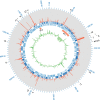Genomic and proteomic characterization of "Candidatus Nitrosopelagicus brevis": an ammonia-oxidizing archaeon from the open ocean
- PMID: 25587132
- PMCID: PMC4313803
- DOI: 10.1073/pnas.1416223112
Genomic and proteomic characterization of "Candidatus Nitrosopelagicus brevis": an ammonia-oxidizing archaeon from the open ocean
Abstract
Thaumarchaeota are among the most abundant microbial cells in the ocean, but difficulty in cultivating marine Thaumarchaeota has hindered investigation into the physiological and evolutionary basis of their success. We report here a closed genome assembled from a highly enriched culture of the ammonia-oxidizing pelagic thaumarchaeon CN25, originating from the open ocean. The CN25 genome exhibits strong evidence of genome streamlining, including a 1.23-Mbp genome, a high coding density, and a low number of paralogous genes. Proteomic analysis recovered nearly 70% of the predicted proteins encoded by the genome, demonstrating that a high fraction of the genome is translated. In contrast to other minimal marine microbes that acquire, rather than synthesize, cofactors, CN25 encodes and expresses near-complete biosynthetic pathways for multiple vitamins. Metagenomic fragment recruitment indicated the presence of DNA sequences >90% identical to the CN25 genome throughout the oligotrophic ocean. We propose the provisional name "Candidatus Nitrosopelagicus brevis" str. CN25 for this minimalist marine thaumarchaeon and suggest it as a potential model system for understanding archaeal adaptation to the open ocean.
Keywords: archaea; genome streamlining; marine metagenomics; nitrification.
Conflict of interest statement
The authors declare no conflict of interest.
Figures



Similar articles
-
Patterns of thaumarchaeal gene expression in culture and diverse marine environments.Environ Microbiol. 2018 Jun;20(6):2112-2124. doi: 10.1111/1462-2920.14107. Epub 2018 Apr 30. Environ Microbiol. 2018. PMID: 29626379
-
Differentiated Evolutionary Strategies of Genetic Diversification in Atlantic and Pacific Thaumarchaeal Populations.mSystems. 2022 Jun 28;7(3):e0147721. doi: 10.1128/msystems.01477-21. Epub 2022 Jun 13. mSystems. 2022. PMID: 35695431 Free PMC article.
-
Genome sequence of "Candidatus Nitrosopumilus salaria" BD31, an ammonia-oxidizing archaeon from the San Francisco Bay estuary.J Bacteriol. 2012 Apr;194(8):2121-2. doi: 10.1128/JB.00013-12. J Bacteriol. 2012. PMID: 22461555 Free PMC article.
-
Mesophilic Crenarchaeota: proposal for a third archaeal phylum, the Thaumarchaeota.Nat Rev Microbiol. 2008 Mar;6(3):245-52. doi: 10.1038/nrmicro1852. Nat Rev Microbiol. 2008. PMID: 18274537 Review.
-
Nitrogen metabolism and kinetics of ammonia-oxidizing archaea.Methods Enzymol. 2011;496:465-87. doi: 10.1016/B978-0-12-386489-5.00019-1. Methods Enzymol. 2011. PMID: 21514476 Review.
Cited by
-
Ecological Aerobic Ammonia and Methane Oxidation Involved Key Metal Compounds, Fe and Cu.Life (Basel). 2022 Nov 7;12(11):1806. doi: 10.3390/life12111806. Life (Basel). 2022. PMID: 36362966 Free PMC article. Review.
-
Comparative Genomics Reveals Ecological and Evolutionary Insights into Sponge-Associated Thaumarchaeota.mSystems. 2019 Aug 13;4(4):e00288-19. doi: 10.1128/mSystems.00288-19. mSystems. 2019. PMID: 31409660 Free PMC article.
-
Analysis of biomass productivity and physiology of Nitrososphaera viennensis grown in continuous culture.Front Microbiol. 2023 Feb 16;14:1076342. doi: 10.3389/fmicb.2023.1076342. eCollection 2023. Front Microbiol. 2023. PMID: 36876066 Free PMC article.
-
Comparative Proteomics of Three Species of Ammonia-Oxidizing Bacteria.Front Microbiol. 2018 May 14;9:938. doi: 10.3389/fmicb.2018.00938. eCollection 2018. Front Microbiol. 2018. PMID: 29867847 Free PMC article.
-
The compact genome of the sponge Oopsacas minuta (Hexactinellida) is lacking key metazoan core genes.BMC Biol. 2023 Jun 19;21(1):139. doi: 10.1186/s12915-023-01619-w. BMC Biol. 2023. PMID: 37337252 Free PMC article.
References
-
- Karner MB, DeLong EF, Karl DM. Archaeal dominance in the mesopelagic zone of the Pacific Ocean. Nature. 2001;409(6819):507–510. - PubMed
-
- Brochier-Armanet C, Boussau B, Gribaldo S, Forterre P. Mesophilic Crenarchaeota: Proposal for a third archaeal phylum, the Thaumarchaeota. Nat Rev Microbiol. 2008;6(3):245–252. - PubMed
-
- Spang A, et al. Distinct gene set in two different lineages of ammonia-oxidizing archaea supports the phylum Thaumarchaeota. Trends Microbiol. 2010;18(8):331–340. - PubMed
-
- Tully BJ, Nelson WC, Heidelberg JF. Metagenomic analysis of a complex marine planktonic thaumarchaeal community from the Gulf of Maine. Environ Microbiol. 2012;14(1):254–267. - PubMed
Publication types
MeSH terms
Substances
Associated data
- Actions
LinkOut - more resources
Full Text Sources
Other Literature Sources
Molecular Biology Databases
Miscellaneous

